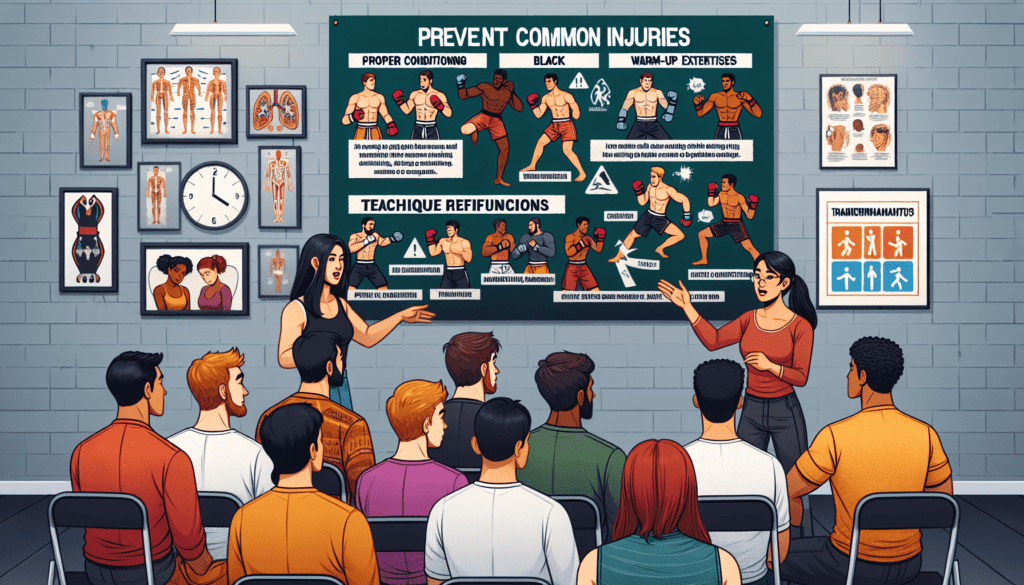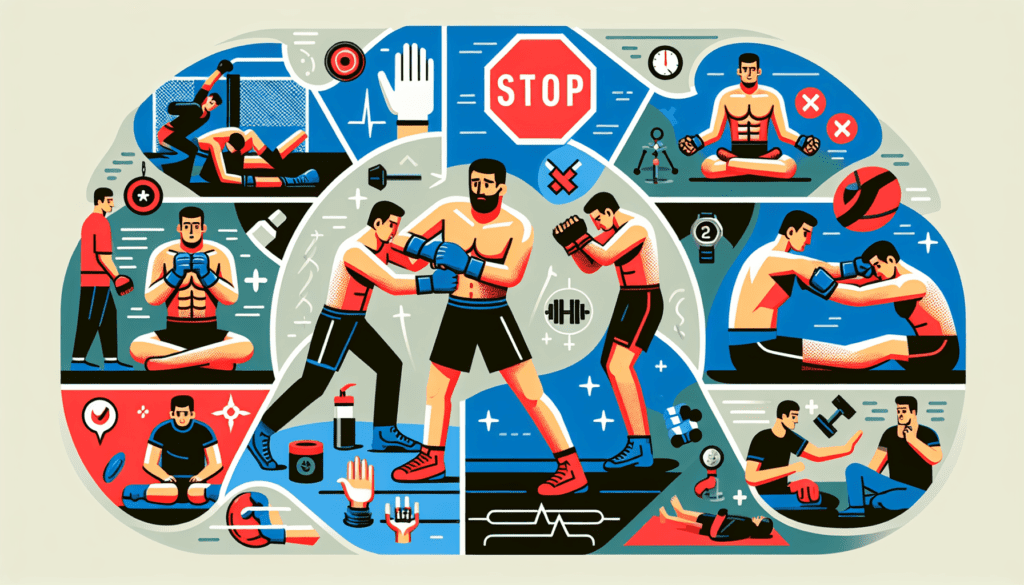If you’re passionate about Mixed Martial Arts (MMA) and want to keep pushing yourself to new heights, it’s crucial to prioritize your safety and well-being. In the fast-paced world of MMA, injuries are no stranger, but that doesn’t mean you have to accept them as inevitable. By adopting a proactive approach and implementing some simple yet effective strategies, you can greatly reduce the risk of common MMA injuries. From proper warm-ups and cool-downs to investing in quality protective gear, this article will guide you on the path to a safer and injury-free MMA journey. So lace up your gloves, tighten your chin strap, and let’s explore the preventive measures that will keep you in the game for the long run.

Warm-up and Stretching
Importance of warm-up
Before diving into any intense physical activity, it is absolutely crucial to properly warm up your body. Warm-ups gradually increase your heart rate, improve blood flow to your muscles, and prepare your body for the upcoming rigorous training session. Not only does warming up help prevent injuries, but it also enhances your overall performance. So, never underestimate the importance of a good warm-up!
Dynamic stretching
Dynamic stretching involves moving parts of your body through a full range of motion. Unlike static stretching, where you hold a stretch for a specific period of time, dynamic stretching involves continuous movement. This type of stretching helps improve your flexibility and muscle coordination, while also increasing your body’s core temperature. Incorporating dynamic stretching exercises into your warm-up routine will help activate your muscles and prepare them for the demands of MMA training.
Static stretching
While dynamic stretching is great for warming up, static stretching is more suitable as a cool-down activity. After your MMA session, static stretching can help improve your flexibility and prevent muscle soreness. Hold each stretch for 15 to 30 seconds, focusing on the major muscle groups used during your training. Remember to breathe deeply and never bounce while stretching. Static stretching is an effective way to relax your muscles after intense physical activity.
Joint mobility exercises
To keep your joints healthy and functional, it is essential to incorporate joint mobility exercises into your warm-up routine. These exercises involve the controlled movement of your joints through their full range of motion, promoting lubrication and improving overall joint health. These exercises are especially important for MMA athletes, as they involve a wide range of movements that put stress on various joints. Including joint mobility exercises in your warm-up helps reduce the risk of joint-related injuries during training or competitions.
Proper Technique and Form
Importance of proper technique
One of the fundamental aspects of MMA training is mastering proper technique and form. Executing techniques with precision not only ensures optimal performance but also significantly lowers the risk of injuries. When applying strikes, takedowns, or submissions, it is critical to maintain the correct posture, body alignment, and weight distribution. It is worth investing time in learning and perfecting the proper technique before progressing to more advanced skills, as it forms the foundation for your progression in MMA.
Seek professional training
To truly master the art of MMA and develop good technique, it is highly recommended to seek professional training. Joining a reputable gym or finding an experienced coach can make a world of difference in your training journey. Professional trainers can provide valuable guidance, correct your form, and teach you the best practices for injury prevention. They have the knowledge and expertise to tailor training plans to your individual needs, ensuring you progress safely and effectively.
Focus on fundamentals
While it may be tempting to jump into flashy and advanced techniques right away, focusing on the fundamentals is paramount. Mastering the basics of striking, grappling, and defensive maneuvers will build a strong foundation for your MMA career. Additionally, practicing the fundamentals allows you to develop proper muscle memory, which plays a crucial role in executing techniques swiftly and efficiently. By continually refining your fundamental skills, you will consistently improve and reduce the risk of injury during training and competitions.
Regular practice
Consistency is key when it comes to developing proper technique and form in MMA. Regular practice is vital to ingraining the correct movements into your muscle memory and developing the necessary balance and coordination for various techniques. Set aside dedicated time for training sessions, and aim for consistency rather than sporadic intense training sessions. By establishing a regular training routine, you are more likely to progress steadily and maintain a higher level of skill while minimizing the risk of injury.
Protective Gear
Mouthguard
In contact sports like MMA, protecting your teeth and jaw is of utmost importance. Wearing a properly fitted mouthguard significantly reduces the risk of dental and jaw injuries, as it absorbs and distributes the impact of blows to the face. A mouthguard also helps protect against concussions and reduces the chance of biting your tongue or cheeks during intense fights. Invest in a high-quality mouthguard and make it a non-negotiable item in your training and competition gear.
Headgear
To protect your head from potential impact and minimize the risk of head trauma, headgear is an essential piece of protective gear in MMA. It provides padding and cushioning, reducing the force of strikes and minimizing the potential for cuts and bruises. Headgear also aids in safeguarding your temples, forehead, and ears from accidental hits during sparring sessions. Choose headgear that fits comfortably and snugly, offering optimal protection without restricting your vision or movement.
Hand wraps and gloves
Protecting your hands and wrists is vital in MMA, as a significant number of injuries occur in this area. Hand wraps and gloves provide crucial support and padding, reducing the risk of fractures, dislocations, and other hand-related injuries. Hand wraps stabilize the wrist joint and provide additional compression to the knuckles, while gloves offer an extra layer of cushioning and protection. Always wrap your hands properly and invest in high-quality gloves that fit snugly and offer adequate padding.
Shin guards
Leg kicks are a common technique in MMA, and protecting your shins is essential to prevent serious injuries. Shin guards offer crucial support and padding, reducing the risk of fractures, contusions, and other leg-related injuries. They provide a protective barrier for your shins and help absorb the impact of kicks during sparring and training. Look for shin guards that fit securely and cover a substantial portion of your shin while allowing for proper movement and flexibility.
Strength and Conditioning
Develop overall strength
One of the key pillars of injury prevention in MMA is maintaining overall strength. Strengthening your muscles aids in stabilizing your joints and reducing the risk of strains, sprains, and other muscular injuries. Incorporate resistance training exercises into your routine that target all major muscle groups, including your arms, legs, core, and back. Focus on compound exercises like squats, deadlifts, bench press, and rows to build functional strength that translates into improved performance and injury resilience.
Improve muscular endurance
In MMA, fights can last several rounds, demanding significant muscular endurance from athletes. To prevent early fatigue and reduce the risk of injuries, it is important to improve your muscular endurance through specific training methods. High-intensity interval training (HIIT), circuit training, and endurance-focused exercises like burpees and mountain climbers can significantly increase your aerobic and anaerobic capacity. By improving your muscular endurance, you can maintain optimal performance throughout the entirety of a fight and reduce the likelihood of injuries due to fatigue.
Increase flexibility
Flexibility plays a crucial role in both injury prevention and performance enhancement. Having good flexibility allows for a greater range of motion in your joints, reducing the risk of strains and tears. Incorporate regular stretching and flexibility exercises into your training routine, focusing on the major muscle groups used in MMA. Explore different stretching techniques like static stretching, dynamic stretching, and proprioceptive neuromuscular facilitation (PNF) stretching to improve flexibility and joint mobility.
Enhance cardiovascular fitness
MMA requires significant cardiovascular endurance, as fights can be physically demanding and intense. Improving your cardiovascular fitness is essential for sustaining high levels of performance and reducing the risk of fatigue-related injuries. Engage in cardiovascular exercises such as running, swimming, cycling, or using an elliptical machine to elevate your heart rate and challenge your cardiovascular system. By enhancing your cardiovascular fitness, you will be better equipped to handle the demands of MMA training and competitions.

Weight Cutting Safety
Consult with professionals
Weight cutting is a common practice in combat sports, including MMA. However, it can pose serious risks to your health if not done properly. To ensure your weight cutting process is safe, it is vital to consult with professionals, such as nutritionists or certified strength and conditioning specialists. These experts can help you create a personalized weight cutting plan that takes into account your individual body composition, training schedule, and competitive goals. Their guidance will help you cut weight gradually and safely, minimizing the risk of dehydration, nutrient deficiencies, and other detrimental effects.
Gradual weight loss
Rapid and extreme weight loss methods are not only dangerous to your health but can also negatively impact your performance and increase the risk of injuries. Instead, opt for gradual weight loss methods that allow your body to adjust and maintain its overall health and function. Plan your weight cutting process over a sustained period, focusing on losing a healthy and manageable amount of weight each week. This approach will help you maintain energy levels, preserve muscle mass, and prevent the negative consequences associated with drastic weight cutting techniques.
Maintain hydration and nutrition
Proper hydration and nutrition are vital during weight cutting to ensure your body functions optimally and remains healthy. Dehydration can lead to reduced performance, muscle cramps, and an increased risk of injury. Fuel your body with a well-balanced diet that supports both your weight loss goals and your overall health. Consume plenty of water, electrolytes, lean proteins, complex carbohydrates, and healthy fats to maintain proper hydration, replenish your energy stores, and support optimal bodily functions.
Monitor physical and mental health
Weight cutting can take a toll on your physical and mental well-being if not managed carefully. Prioritize regular check-ins with your coaches, trainers, and healthcare professionals to monitor your overall health and well-being throughout the weight cutting process. Keep a close eye on any signs of fatigue, weakness, dizziness, mood changes, or other symptoms that may indicate inadequate weight cutting practices. By closely monitoring your physical and mental health, you can adjust your weight cutting plan as needed to ensure your safety and well-being.
Injury Prevention Exercises
Core strengthening exercises
A strong and stable core is essential for injury prevention in MMA. Core strengthening exercises help improve your balance, stability, and overall body control, reducing the risk of falls, strains, and other injuries. Include exercises like planks, Russian twists, leg raises, and medicine ball rotations in your training routine to target your core muscles effectively. Strengthening your core not only enhances your performance but also provides added protection for your spine, hips, and other vulnerable areas during intense fighting situations.
Balance and stability training
Having good balance and stability is key to avoiding injuries in MMA. Balance and stability training exercises help improve your proprioception and body awareness, allowing you to maintain stability, control, and agility during diverse movements and positions. Incorporate exercises such as single-leg stands, Bosu ball exercises, and yoga poses that challenge your balance and stability. By developing these skills, you will be better equipped to avoid falls, recover from off-balance situations, and reduce the risk of joint and muscle injuries.
Resistance training for specific muscle groups
MMA involves a wide range of movements and techniques that require different muscle groups to work together effectively. Targeted resistance training exercises can help strengthen specific muscle groups used in MMA, reducing the risk of imbalances and injuries. Focus on exercises that target the muscles involved in striking, grappling, and explosive movements, such as bicep curls, tricep extensions, pull-ups, push-ups, squats, and lunges. By training specific muscle groups, you can enhance their strength and endurance, improving your performance and reducing the likelihood of injuries.
Plyometric exercises
Plyometric exercises are explosive movements that incorporate jumping, hopping, and bounding to increase power, speed, and overall athleticism. These exercises help improve your muscular strength, coordination, and reaction time, making them beneficial for injury prevention in MMA. Include plyometric exercises like box jumps, jump squats, clap push-ups, and medicine ball throws in your training routine to develop explosive power and reduce the risk of muscle strains and tears. However, it is crucial to gradually progress into plyometric training and perform exercises with proper form to avoid overexertion and injury.

Rest and Recovery
Importance of rest days
Rest days are just as crucial as training days, as they allow your body to recover and rejuvenate. Rest days give your muscles and joints time to repair and rebuild, reducing the risk of overuse injuries and fatigue. It is important to listen to your body and incorporate rest days into your training schedule to prevent burnout and maintain optimal performance. Remember, rest is not a sign of weakness but a necessary component of long-term success and injury prevention in MMA.
Proper sleep and relaxation
Proper sleep is vital for both mental and physical recovery in MMA. During sleep, your body repairs damaged tissues, releases growth hormone, and restores energy levels. Aim for a minimum of seven to nine hours of quality sleep each night to promote optimal recovery and reduce the risk of injuries. Additionally, incorporating relaxation techniques such as deep breathing, meditation, or yoga can help manage stress, enhance mental well-being, and improve overall recovery.
Massage and therapy
Regular massages and therapy sessions can greatly contribute to injury prevention and muscle recovery in MMA. Massage therapy helps reduce muscle tension, improve blood flow, and enhance flexibility, all of which can reduce the risk of injuries. Consider incorporating deep tissue massages, sports massages, or foam rolling into your routine to aid in muscle recovery and alleviate muscular imbalances. Additionally, alternative therapies like chiropractic adjustments, acupuncture, or physical therapy can provide additional benefits to your recovery process.
Nutrition and hydration
Proper nutrition and hydration play a crucial role in rest and recovery. Fueling your body with a well-balanced diet that includes an adequate amount of macronutrients and micronutrients is essential for optimal muscle repair and recovery. Hydration is also vital, as it helps transport nutrients to your muscles, lubricate joints, and maintain overall body function. Aim to consume nutrient-dense foods, emphasizing lean proteins, whole grains, fruits, vegetables, and healthy fats. Additionally, ensure you stay properly hydrated throughout the day by drinking water consistently.
Listen to Your Body
Recognize warning signs
Listening to your body is one of the most important aspects of injury prevention in MMA. Pay close attention to any warning signs that your body may be sending, such as persistent pain, unusual fatigue, decreased performance, or feelings of discomfort. These signals are your body’s way of communicating that something may be wrong. Ignoring these warning signs can lead to more severe injuries and potential long-term damage. Therefore, always prioritize your health and well-being by promptly addressing any concerns and seeking appropriate medical attention when needed.
Manage and treat minor injuries
In the world of combat sports, minor injuries are bound to occur. It is crucial to manage and treat these injuries properly to prevent them from worsening or becoming chronic issues. Follow the RICE method – rest, ice, compression, and elevation – to minimize swelling, reduce pain, and aid in the healing process. Additionally, consider using over-the-counter pain relievers or topical creams as directed by medical professionals to alleviate discomfort. If the injury persists or worsens, consulting with a healthcare provider is essential to receive an accurate diagnosis and appropriate treatment plan.
Avoid training through pain
Pain is your body’s way of telling you that something is wrong. Training through pain can exacerbate injuries and lead to more severe damage, impairing your ability to train and compete in the long run. If you experience pain during training or competition, it is crucial to stop and address the issue. Pushing through pain will not only hinder your performance, but it may also result in more significant injuries that require extended recovery periods. Be mindful of your body’s signals and prioritize your health by seeking appropriate medical attention when needed.
Seek medical attention when needed
When it comes to injuries in MMA, it is always better to be safe than sorry. If you experience a significant injury or are unsure about the severity of an injury, seeking medical attention is paramount. Medical professionals can accurately diagnose the injury, determine the appropriate treatment plan, and provide invaluable guidance on the recovery process. Ignoring injuries or attempting to self-diagnose and self-treat can lead to long-term damage and hinder your progress in the sport. Prioritize your health and well-being by promptly consulting with a healthcare professional for proper evaluation and care.

Avoid Overtraining
Know your limits
Overtraining occurs when you exceed your body’s capacity to recover and adapt to physical stress. It is crucial to know your limits and avoid pushing your body beyond its capabilities. Be mindful of your training volume, intensity, and frequency, ensuring they align with your individual fitness level and recovery capacity. Understanding your limits helps prevent overtraining, reduces the risk of injuries, and allows for consistent progress in your MMA journey.
Schedule rest periods
Incorporating rest periods into your training schedule is essential to prevent overtraining and promote optimal recovery. Plan regular rest days where you engage in low-intensity activities or completely refrain from training. Additionally, include active recovery sessions in your routine, such as light cardio, mobility exercises, or yoga, to aid in the recovery process while still maintaining an active lifestyle. Giving your body adequate time to recover and recharge is crucial for preventing overtraining and optimizing performance.
Mix up training routine
Repetitive training routines can lead to overuse injuries and stagnated progress. To prevent these issues, it is important to mix up your training routine and incorporate variety. Incorporate different training modalities, such as striking, grappling, strength training, and conditioning exercises, to engage different muscle groups and prevent imbalances. Additionally, periodically introduce new techniques, drills, or equipment to keep your training fresh and exciting. By diversifying your training routine, you reduce the risk of overtraining and allow for continued progress in your skills and physical fitness.
Focus on quality over quantity
In MMA training, quality always triumphs over quantity. It is more beneficial to have a purposeful and focused training session than to spend countless hours in the gym aimlessly. Prioritize quality technique, form, and intensity during your sessions, ensuring each movement is executed with precision. This not only optimizes your skill development but also minimizes the risk of injuries caused by sloppiness or overexertion. By focusing on quality training, you can make the most of your time spent in the gym while still preventing overtraining and promoting injury prevention.
Sportsmanship and Respect
Fight with honor
In MMA, sportsmanship and honor are integral aspects of the sport. Maintain a mindset of respect towards your opponent, the sport itself, and its rules. Displaying honorable conduct throughout your fights, both inside and outside the cage, not only contributes to a positive and healthy MMA community but also helps prioritize the safety of all athletes. Show respect to your opponent before, during, and after the fight, and compete with integrity and fairness.
Follow rules and regulations
Respecting and adhering to the rules and regulations of MMA is not only a requirement but also a crucial component of injury prevention. Rules are established to protect the fighters and ensure fair and safe competitions. Familiarize yourself with the rules and regulations applicable to your specific MMA organization or governing body, and always compete within those boundaries. By following the rules, you contribute to a safer environment for all participants and reduce the risk of unnecessary injuries.
Respect your opponents
MMA is a combat sport that requires physicality and intensity, but it is vital to approach every fight with respect for your opponent. Recognize and acknowledge their skills, dedication, and commitment to the sport. Treat your opponents with respect and dignity, both in and out of the cage. Foster a spirit of sportsmanship and camaraderie, understanding that competing against one another is part of the sport rather than a personal vendetta. By respecting your opponents, you contribute to a positive and supportive MMA community that prioritizes safety and well-being.
Prioritize safety over winning
While winning may be a significant goal in MMA, it should never outweigh the importance of safety. Prioritizing the safety of both yourself and your opponent should always be at the forefront of your mind. Refrain from employing dangerous and excessive force in your techniques, and avoid compromising your opponent’s well-being for the sake of victory. Adhere to proper technique, sportsmanship, and the rules of the sport to ensure a safe environment for everyone involved in MMA. Remember, walk away from each fight knowing you did your best while prioritizing the safety and well-being of all athletes.

